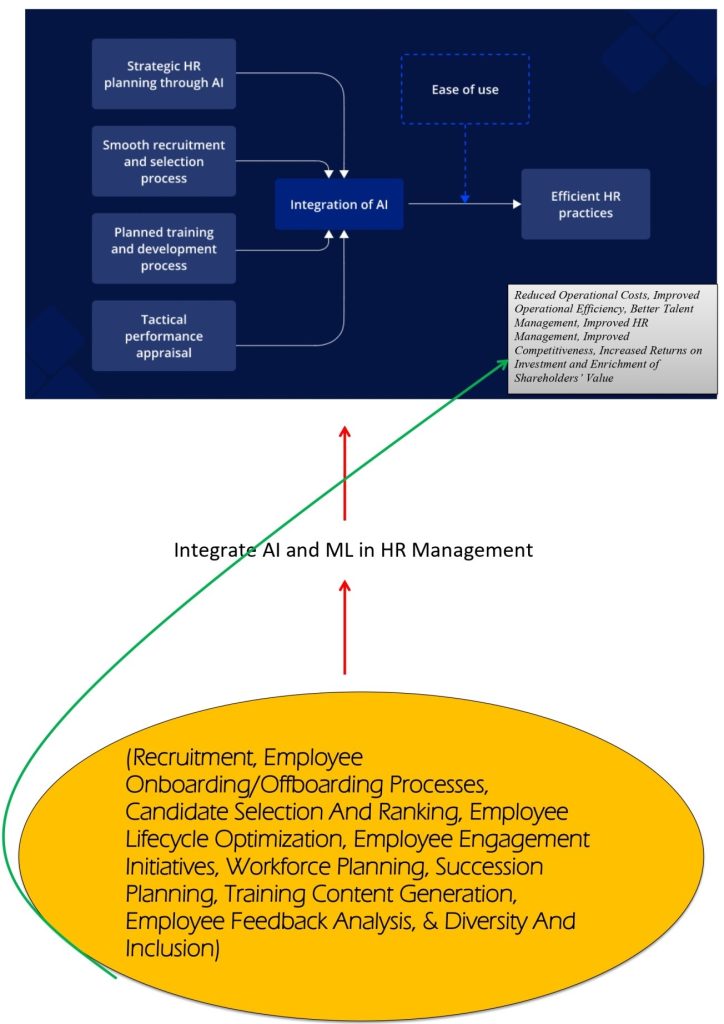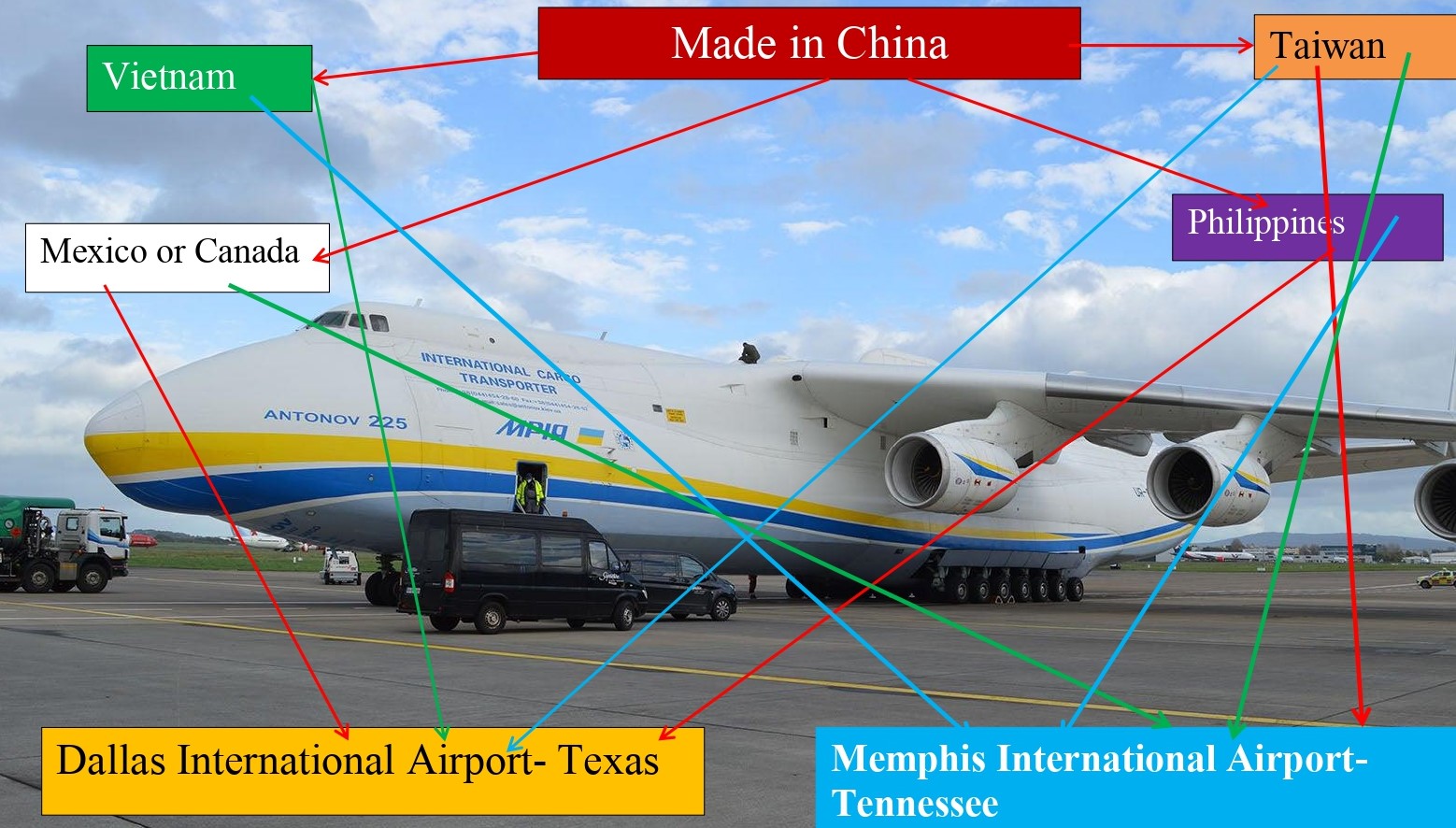By
Denese Fay-Ann John and Jennifer Davis-Adesegha,
London, England, February 2025
Abstract
Thriving in the fintech world where usage of more advanced Fourth Industrial Revolution (4IR) technologies is increasingly becoming the norm requires Fintech Companies to explore all the best possible ways of attaining superior competitive advantage. As part of such quest, this study used a qualitative research approach to examine how usage of AI and machine learning technologies by most of the selected London-based Fintech Companies would enhance HRM operational efficiency. Insights from managers purposively sampled from a cross-section of Fintech Companies operating across the thirty-two London Boroughs indicated AI and machine learning usage to bolster a firm’s HRM operational efficiency. This unlocks cost and differentiation advantages to spawn the fintech’s overall competitiveness. In the increasingly disruptive 4IR Era, this improves a firm’s capability to excel and achieve the best. However, even though fintech companies are known for using more advanced 4IR technologies, findings indicated most London-based Fintech companies had not yet embraced the full use of AI and machine learning applications in their daily HR management activities. There is still a strong belief that, as compared to HR management, which requires manual processes, usage of AI and machine learning tends to be more suitable for just automating marketing, operational and other management processes. When it comes to personnel recruitment, usage of manual approach is construed as more suitable. By directly engaging with potential candidates on a one-on-one physical basis, some fintech executives feel that they can recruit and deploy the best. Such unsupportive business philosophy was found to be further exacerbated by lack of an appropriate strategy for AI and ML usage in HRM, and poor investment in proper AI, big data and machine learning technologies. To respond such challenges, findings imply that if fintech companies and other forms of businesses are to thrive, it is essential to adopt a framework analogous to Leeway-Hertz’s “Model for AI usage in HRM.”
Keywords: Artificial Intelligence; Machine Learning; HRM; Operational Efficiency; Fintech Companies; Competitiveness
INTRODUCTION
Integration of artificial intelligence (AI) and machine learning (ML) in human resource management (HRM) activities bolsters a firm’s operational efficiency. It eliminates glitches in HRM’s operational activities to lower costs whilst also improving the speed and quality of the made HR decisions (Evseeva et al., 2021). This catalyses a firm’s effective performance and competitiveness. Such advancement in AI technologies signifies attaining a competitive edge in the increasingly more disruptive fourth industrial revolution (4IR) era requires businesses to integrate all forms of Industry 4.0 technologies in all aspects of their operations.
In the 4IR era, Industry 4.0 technologies connote a nexus of technologies like artificial intelligence (AI), cloud computing, robotics, machine learning (ML), additive manufacturing, digital twin, big data analytics, cybersecurity, and Internet of Things (Jędrzejowska, 2024). It is these technologies that are increasingly reshaping and revolutionising not only how businesses accomplish their activities, but also how humans live life. To leverage competitiveness, businesses are increasingly integrating AI and machine learning usage in functional business areas like marketing, operational management, manufacturing, and distribution as well as human resource (HR) management.
Integration of the required 4IR technologies like artificial intelligence, robotics, and machine learning in human resource management bolsters a firm’s overall competitiveness (Saxena, 2020). It spawns improved competitiveness on all the three dimensions that Michael Porter outlined in 1986 to encompass cost, differentiation, and focus. AI and machine learning usage in HR management automates all the critical HR management processes. This reduces the nature of human costs as well as the other manual-related costs that often arise from the accomplishment of HR activities like HR analysis, identification of job vacancies, vacancy advertisement, recruitment, deployment, performance management, and succession planning. In general, artificial intelligence connotes the use of computers to simulate human intelligence and actions and programme computer-driven machines to accomplish tasks that should have been accomplished by humans (Mazurchenko et al., 2019).
Machine learning is a branch of AI that uses certain computer algorithms and data to learn, predict, and improve how certain business tasks must be accomplished. During HR analytics, AI and machine learning automate the overall process of analysing, gathering, evaluating, and interpreting the gathered data to discern areas requiring more personnel. With limited management intervention, AI and machine learning algorithms also indicate the kinds of the required skills, talents, expertise, and years of experience (Jose, 2019). This influences the accuracy of HR decision-making on the kinds of skills and talents that it must source.
With such insights, AI and ML still improve the recruitment process by facilitating faster diffusion of vacancy advertisements across all digital platforms. AI explores and matches the advertised vacancies to the designated candidates. In that process, vacancy advertisements tend to automatically appear on the newsfeed of most potential candidates. This enhances the drawing of candidates’ attention to the existence of vacancies that could be suitable for their interests and qualifications (Martínez-Morán et al., 2021). As this lowers costs, CTV’s (2024) video below implies the automated actual recruitment processes of matching and ranking candidates from the most suitable to the less suitable candidates also reduce human costs and subsequently the overall operational costs. This improves the quality of the recruited personnel to bolster the innovative capabilities of the business to create and use better processes and products.
As these create and deliver unique values for customers, it also creates points of difference that leverage a firm’s competitiveness on the basis of differentiation (Kim, 2022). AI and machine learning usage in human resource management improves a firm’s competitiveness on the basis of cost, differentiation and focus. To discern how the business is responding to customer needs, AI and machine learning algorithms are used to assess the overall performance of each employee. This aids discerning areas requiring improvement as well as the areas of strength that must be further built to bolster a firm’s overall effective performance (Batho & Davis, 2024).
During HR forecasting and succession planning, AI and machine learning applications help businesses assess whether or not they will experience shortages or excesses of certain skills, talents, expertise, and experience in the future. Through such insights, the business is able to discern the proactive plans and actions that it must use to avoid being affected by the unfolding shortages. Though this bolsters a business’s continuity, sustainability, and improved competitiveness, usage of artificial intelligence and machine learning is still a challenge that most businesses are increasingly grappling with (Leeway-Hertz, 2024). Usage of AI is more appreciated in other areas like operational management, marketing, supply chain management, forecasting and budgeting, but not for enhancing the effectiveness of HR management. To explore the underlying rationale of such business philosophy, this study evaluates the level of AI and ML usage in HRM operations by London-based Fintech Companies. Through such analysis, the study aims to discern the major limitations and the improvement initiatives that must be adopted.
HRM in the Era of AI and Machine Learning
Thriving in the era of high level of digitisation implies usage of artificial intelligence (AI) and machine learning is becoming increasingly important for bolstering a business’ effective performance. AI leverages the operational efficiency of human resource management (Merlin & Jayam, 2018). Human resource management is one of the fundamental business functions that connote the strategic process of analysing, planning, organising, controlling, and leading how the required business personnel can be accessed, recruited, and deployed to influence attainment of the desired business outcomes. Usage of AI and machine learning is essential for enhancing the effectiveness of the labour market vis-à-vis internal business condition analysis, labour gap identification, talent searching, interviewing, recruitment and deployment. It also enhances effective management of performance to influence attainment of the desired outcomes (Hwang, 2019).
AI and machine learning use a combination of various algorithms to enhance the accomplishment of such key HR activities in a way that influences attainment of the designated business goals and objectives. Artificial intelligence refers to a combination of machine learning algorithms that are programmed to computers to simulate, mimic, and replicate the nature of human intelligence to creatively diagnose, comprehend, and make decisions to solve the identified problem in a way that even surpasses the accuracy of human capabilities (Singh & Shaurya, 2021).
However, following Alan Turing’s (1950) introduction of the notion of “Computing Machinery and Intelligence” and subsequent studies by McCarthy and Rosenblatt, the concept of artificial intelligence has evolved to encompass machine learning, deep learning, and generative AI (Stryker & Kavlakoglu, 2024). Though these concepts are related, machine learning is still a subset of artificial intelligence that uses certain algorithms to gather, analyse, and learn from the existing larger volumes of data to make predictions without necessarily being programmed to accomplish specific tasks. In addition to algorithms like k-nearest neighbour (KNN) and support vector, it is the neural network which is the commonly used machine learning algorithm due to its capabilities to easily diagnose and solve more complex problems. Modelled to reflect human brain structure, components, and functions, Voice of America’s (2024) Video below depicts neural network is made of interconnected layers of nodes analogous to neurons to seamlessly operate together to gather, process, analyse, and draw meaningful interpretations about the unfolding patterns and relationships from more complex data.
While machine learning uses a supervised learning approach, deep learning uses unsupervised learning. Without issuing any specific instructions, deep learning or deep neural networks is a subset of machine learning that uses a combination of various hidden input and output layers that closely mimic human brain function to evaluate and make its own predictions from the existing data without being supervised or guided to do so (Evseeva et al., 2021). It was the breakthrough in deep learning studies in the 1980s that re-ignited interest in artificial intelligence that had been abandoned for being useful for just accomplishing simple routine tasks like picking a box and placing it in another place without capabilities to pick up the box if it falls before reaching the final destination.
As deep learning evolved to consist of semi-supervised, self-supervised, reinforcement, and transfer learning, the concept of generative AI emerged to depict a set of deep learning models used for creating complex original content like high-quality images, realistic audio or videos, and product designs as accurately requested by the user (Roy, 2022; Ekuma, 2024). To accomplish that, generative AI uses three phases encompassing training aimed at creating a foundation model, tuning to adapt the model to specific applications, and evaluation to improve accuracy.
Given the increasing business values created by AI and machine learning in various business organisations, AI and machine learning are not only being increasingly integrated into business activities like product design, marketing, and operational management, but also into human resource management. In HR management, AI plays instrumental roles in improving the efficacy of HR management in the three main critical areas encompassing: workforce planning and recruitment, employee engagement and remuneration, and performance evaluation and management (Jędrzejowska, 2024).
Workforce Planning
During the evaluation of recruitment decisions in terms of the number of required new employees and skills, AI and machine learning bolster the effectiveness of workforce planning. Workforce planning is the analysis of the external business environment vis-à-vis the internal business conditions to discern the skills gap that must be filled or the excess available skills that must be addressed by freezing recruitment until new skills are required in the future (Odugbesan et al., 2023). Workforce planning is essential for balancing skills supply with demand. While using big data, AI tends to bolster the overall effectiveness of workforce planning. Big data aids the retrieval of historical data whilst also gathering, analysing, and interpreting the unfolding present trends to make comparisons and predictions about the likely future market changes.
AI improves the efficiency of data gathering and analysis to enable the business to understand whether or not it will require more personnel in the context of the unfolding internal and external business trends (Malik et al., 2022). Through the evaluation of such trends, AI enables the business to discern the kinds of new skills required depending on the changes in market trends as well as the increasing use of new technologies by rivals.
Radical changes in technologies or the introduction of rival disruptive products suggest the business must recruit and deploy new skills to boost its existing competencies and capabilities if it is to survive (Panda et al., 2023). This signifies that as AI leverages the effectiveness of workforce planning, it also bolsters competitor analysis and intelligence gathering. This informs critical business actions that can be undertaken to respond to the unfolding disruptive trends.
As the business adopts the recruitment of new skills as one of the strategies for bolstering its competitiveness, AI enhances the promotion and diffusion of the advertisement messages to the larger potential candidates in the wider labour market (Saxena, 2020). While integrating the traditional TV and Radio job advertisements with online advertisements, AI uses certain algorithms that facilitate the analysis, matching, and informing of the potential candidates about the prevailing advertised vacancies.
In that process, AI improves the precision of advertisement by evaluating, identifying, and informing the best candidates. This improves the quality of the candidates responding to the advertisement as well as the quality of the talents that the business subsequently selects, recruits, and deploys as part of its critical resources and capabilities (Mazurchenko et al., 2019). Yet as AI improves the faster online diffusion of job advertisements, it also reduces costs of talent search and repeated advertisements, which are often undertaken to enhance the attraction of the best candidates.
During selection processes, AI enhances the scheduling of interviews. It also improves the cost-effective and easy ranking and comparing of resumes as well as the summarised interview data using criteria like years of experience, technical skills and knowledge, interpersonal skills, disruptive businesses involved, and other criteria (Martínez-Morán et al., 2021). This not only reduces the costs of human resource selection but also aids in the selection of the best candidates. Once the employees are onboarded to settle as part of the critical organisational resources, AI and machine learning still become essential for improving employee engagement and motivation.
Employee Motivation
While the employees go about accomplishing the allocated tasks, AI is often used to improve the management’s engagement with employees. This improves the understanding and response to the dynamics affecting employees’ effective performance (Batho & Davis, 2024). In that process, AI-supported survey tools are often used to extract insights from the employees about any areas of the organisational performance. Though it is just a performance improvement initiative, it also enables management to identify a few issues that must be addressed to improve employee job satisfaction. Besides chatbots, AI-voice-bots have also become quite popular for using texts and vocal interactions to respond to any query that the employees could be requiring a response from management (Leeway-Hertz, 2024).
AI-voice-bots are often used for improving customer interactions and marketing, but they are also increasingly being adopted for usage by human resource managers to respond to some of the array of questions that the employees could be posing. Yet as these AI-supported technologies interact with employees, they also generate and store enormous data on various aspects of human resource management (Harrison et al., 2020). Using big data and predictive analytics technologies, the data is often analysed to discern the patterns that explain employees’ behaviours and the concerns that HR must respond to.
Outcomes of such analysis often influence HR’s decision to not only invest in the initiatives that improve work conditions and environment but also in the improvement of employee motivation. From the questions being asked through AI-voice-bots, HR managers are able to discern and respond to areas of dissatisfaction (Jose, 2019). Such areas of dissatisfaction could arise from concerns about work conditions, work hours, work terms in terms of remuneration and wage packages or other issues that affect employee motivation and performance.
Once management is able to respond to such issues, it bolsters improved employee satisfaction and motivation to bolster the employees’ overall effective performance. As AI eases and lowers the costs of human resource management, it also improves the efficacy of payroll processing and administration. In terms of payroll administration, AI improves the business’ analysis and understanding of the nature and standard of pay being given out to various categories of employees across the industry in which it operates (Pillai & Sivathanu, 2020). If the business would like to be recognised as the best employer to work for, it could decide to increase the amounts of benefits offered to the employees. Such standardisation of remuneration and benefits improves employee satisfaction and motivation. In that process, AI leverages the effectiveness of performance management.
Performance Management
Performance management is the process of using certain defined criteria or KPIs (Key Performance Indicators) to assess whether, given the current employees’ status and level of employment, they are most likely to achieve or not attain the designated organisational goals and objectives (Bresciani et al., 2018). Using the online dashboards put in place, AI enables the easy collection, analysis, interpretation, and response to employees’ data indicating poor performance may be linked to lack of skills, poor competencies, inadequate financial resources, shortage of equipment, or poor work conditions and climate. AI has the capabilities to rank the severity of KPIs from the most severe, requiring immediate attention, to the least severe KPIs that can be acted on later (Palos-Sánchez et al., 2022). This enables HR managers to discern the improvement initiatives that must be introduced to improve employees’ effective performance.

In the event that training is required, AI also evaluates the existing employees’ data to discern and indicate the areas where training is required, as well as the list of employees who must be subjected to training to improve their overall effective performance. This improves the efficacy of HR managers’ decisions on the required training programmes, as well as the areas where training is required (Giraud et al., 2022). In that process, AI also plays instrumental roles in the development of training manuals, as well as in the assessment of new skills’ transfer and usage by the new employees. However, for businesses to realise the values of AI that lower costs, improve efficiency and productivity to bolster competitiveness, theories suggest effective integration of AI in HRM may require the use of a combination of certain critical strategies (Kim, 2022; Fakhar et al., 2021).
AI-HR Integrated Business Strategy
For AI to influence the efficacy of HR management, the adopted strategy requires clear analysis of the existing industry and business conditions, setting measurable objectives and goals, risk analysis, data quality management, employee training, and measurement and improvement of AI impact (Kim, 2022). In that process, analysis of the prevailing industry trends and internal business conditions is important for the business to understand the unfolding technological trends and whether the business is investing in the use of the best AI technologies as compared to what rivals are already using.
Usage of AI in HR management is not just for bolstering operational efficiency, but also for leveraging competitiveness. To attain such values, the analysis must explore the risks, security and privacy issues that can arise to undermine the effective utilisation of AI as part of the HR management strategies (George & Thomas, 2019). Once HR managers clearly understand their organisation and the unfolding technological trends, it is essential that clear goals and objectives for integrating AI in HR management are clearly outlined and aligned with the larger business strategy.
In that process, some of the goals and objectives that HR can aspire to achieve from utilising AI may encompass improving HR efficiency, cost management, employee collaboration, better decision making, better activities’ coordination and control, improving customer experience, and a business’ competitiveness (Pandey & Khaskel, 2019). It is these critical goals and objectives that often act as the measuring rod for assessing whether AI usage in HR management is influencing the attainment of the desired outcomes. Such goals dictate decisions on the kinds of AI technologies that the business must consider investing in. Goal setting must be accompanied by risk analysis.
Introduction of AI technologies does not only create values for the business, but also risks in terms of compromising confidential business data, security, privacy, and regulatory compliance issues that can attract the need for hefty fines that the business must pay (Kulkarni et al., 2022). It is such risk analysis that improves the successful usage of AI in HR management activities in a way that mitigates such risks to bolster the effective HR management, as well as the overall organisational performance.
Usage of AI in HR management activities may only influence attainment of the desired goals and objectives if management ensures the effectiveness of data quality management. Data quality management ensures data is gathered, processed, stored, retrieved, shared and utilised in a way that does not compromise its accuracy, relevance, value, reliability, and integrity (Jaiswal et al., 2022). This eliminates risks of relying on poor quality data to make critical business decisions, as well as risks of using AI in a way that can compromise certain confidential business data to undermine business reputation and competitiveness.
To reduce such risks whilst also improving data quality management, AI implementation strategy also requires training and developing employees to improve their competencies and skills to deal with and manage all aspects of AI usage in HR management in a way that bolsters effective business management (Buzko, Maurer, & Zotov, 2016). Such initiatives must be accompanied by periodic evaluation and measurement of the impacts of AI usage in HR on improved efficiency, cost reduction, return-on-investment, employee satisfaction, and retention. Even if usage of AI-HR Integrated Business Strategy would influence the successful usage of AI in HR management activities, theories still suggest it must be accompanied by the use of a more effective digital transformation tool (Fakhar et al., 2021). Digital transformation aids the creation of the new digital operational culture that creates an effective foundation for the utilisation of AI in HR management activities.
Whereas digital transformation is a foundational initiative, the introduction of AI usage in HR management reflects a more advanced form of digitisation. In effect, some authors argue that even without an effective AI-HR Integrated Business Strategy, improvement in the investment of more advanced digital technologies often leads to advancement that inadvertently introduces AI usage in HR management (Aggarwal & Kathuria, 2023).
However, attainment of such outcomes also requires use of the appropriate digital business strategy. Such a digital business strategy must reflect clearly defined objectives, usage of the latest digital technologies, employee training and development on digital business operations and management, as well as constant monitoring and evaluation to improve the effectiveness of digital business operations. Through the implementation of these strategies, businesses are able to use AI to not only improve the effectiveness of HR management but also the general operational efficiency (Ariwala, 2024).
AI eliminates the hefty costs of coordinating, controlling and managing employees scattered across complex organisational structures. AI usage automates critical business processes to leverage the level of operational efficiency and productivity. This lowers the unit cost per output to bolster a business’ overall cost competitiveness. In the process of enhancing personalised management-ordinary employees’ interactions, it also tends to enhance the capabilities of the business to obtain and act on more constructive feedback from the employees. This often creates new insights that can be adopted to bolster the business’ overall effective performance (Basnet, 2024). But even if that is the case, quests for increasing AI usage in HR management are often still undermined by a combination of certain factors.
Inhibitors of AI Usage in HR Management
Most impediments of AI usage in HR management often arise from poor investment in digitisation, as well as poor investment in AI, big data, and machine learning technologies (Merlin & Jayam, 2018). In most of the cases, some of the businesses are in a hurry to introduce and use AI technologies when in actual fact they have not fully digitised the overall nature of their business operations. This often creates incompatibilities of technologies, as well as operational cultures that may not support the seamless use of AI and machine learning in the accomplishment of critical business activities. Incompatibilities arising from poor technological upgrades imply some AI technologies may not be supported by the existing information and digital technologies that the business has at its disposal (Hwang, 2019).
In addition to incurring the costs of purchasing AI technologies, this signifies businesses must also upgrade their technologies in order to use AI in the achievement of the desired outcomes. Even if the business has all the compatible technologies, challenges may still arise from poor investment in the acquisition of essential AI, big data, and machine learning technologies (Roy, 2022).
Depending on the scale of business operations, some AI and machine learning technologies are quite expensive and costly for some of the businesses to avoid. The effect is that instead of having their own AI-supported technologies, most of the AI technologies are open-sourced from the larger internet (Singh & Shaurya, 2021). Though this solves business problems, it still exposes the business to risks of having its confidential data and information compromised. Even with some restrictions, usage of open-sourced AI technologies exposes the business to risks of being hacked to have its privacy, as well as the privacy of the individuals using its AI systems, compromised.
Yet as some businesses invest in the introduction of more complex AI, big data, and machine learning technologies, challenges have often arisen from the shortage of essential sophisticated skills to run and operate such machines and technologies in a more creative way to create the desired business values (Odugbesan et al., 2023). The introduction of AI and machine learning technologies just gained momentum in recent years. Hence, skills are developing and improving, but they are still insufficient to respond to the demand for complex AI and machine learning usage and applications.
Skills shortages signify that as the business introduces new AI and machine learning technologies, they must also invest in training and development to equip employees with the required skills and competencies (Malik et al., 2022). But incurring such costs is often a challenge for some businesses that do not have adequate operating capital. In effect, instead of investing in training, some businesses often opt to gamble with the existing poorly skilled and knowledgeable employees, only to undermine how AI and machine learning technologies can be effectively used to create the desired values (Panda et al., 2023).
Quite often, these challenges are compounded by difficulties in changing and transforming the required organisational culture. In quests to bolster their effective performance, most businesses AI and machine learning with the hope that just because such technologies are there, the business will perform well. Unfortunately, that has often not been the case.
Given the capabilities of AI and machine learning to infringe on individual employee privacy, there are often scepticisms and sabotage from even some senior managers to ensure AI and machine learning technologies are effectively utilised in the accomplishment of the required technologies (Ekuma, 2024). This suggests that without changing and transforming organisational culture, it can be challenging for the business to use AI and machine learning technologies to achieve the desired outcomes. Such challenges are not different from the constraints that London-based Fintech Companies experience when seeking to introduce AI and machine learning to leverage their HRM’s operational efficiency.
Since only limited studies have examined this area, it is a nexus of such challenges, as reflected in the research aim, objectives, and questions below, that motivate this study to qualitatively evaluate how London-based Fintech Companies are using artificial intelligence and machine learning to leverage their HRM’s operational efficiency. Through such qualitative analysis, the study aims to extract critical improvement insights that can be adopted to improve not only the understanding but also the enrichment of theories on how AI and machine learning can be used to improve HRM’s operational efficiency.
METHODOLOGY
To thoroughly examine the approaches, impact and limitations affecting the effective utilisation of AI and machine learning technologies in HR management activities, the study used a qualitative research approach. The qualitative research approach is aligned with the interpretivist research paradigm (Creswell & Creswell, 2020). A research paradigm connotes the way of thinking or the underpinning research philosophy that guides the thinking and reasoning in the study. It is the nature of the research paradigm or philosophy that influences the epistemological activities that the investigator accomplishes to reach logical conclusions about the existence or non-existence of the phenomenon being investigated (Roller & Lavrakas, 2021).
In that process, a research paradigm may take the form of positivism, interpretivist or phenomenological thinking or approach. However, this research uses the interpretivist research paradigm. The interpretivist research paradigm refers to the research philosophy that emphasises the importance of eliciting detailed narratives, rich insights and information providing all aspects about why, how, when, what and who of the phenomenon being investigated. Interpretivism, just like the phenomenological research paradigm, encourages the importance of the investigator to interpret and engage in social construction and re-construction of the gathered information as the prerequisite of improving detailed understanding and the overall conclusion about the realities of the concept being investigated (Swaminathan & Mulvihill, 2022).
Though the phenomenological research paradigm is similar to interpretivism, phenomenology still differs on the basis that it is used for studying and understanding cultural behaviours and practices explaining why people do things the way they do. In this study, evaluating organisational culture practices is important for discerning the approaches, impact and limitations that London-based Fintech Companies experience when seeking to use AI and machine learning technologies in the accomplishment of their daily HR management activities.
However, compared to the use of phenomenology, it was interpretivism that was considered more essential for eliciting detailed insights, narratives and in-depth underlying facets of facts explaining the approaches, impact and limitations experienced by London-based Fintech Companies when using AI and machine learning to support the accomplishment of HRM-related activities. Such reasoning also implies the use of positivism would not have offered the required rich insights for responding to the critical research questions of the study. Positivism uses scientific parameters to limit the collection and analysis of only information relevant to such parameters to test the validity of the hypothesis being tested.
The usage of such scientific parameters was found to be an impediment to the collection of rich insights and detailed narratives of the approaches, impact and challenges that London-based Fintech Companies experience when using AI and machine learning in HRM-related activities. To achieve this, the study used a qualitative-exploratory research design as compared to the use of other research designs like experimental or causal research designs that are aligned with positivism (Ravitch & Carl, 2021).
Exploratory research design is often used to elicit detailed insights about new concepts. Since few studies have been conducted on AI and machine learning usage by London-based Fintech Companies, the usage of exploratory research was found to be essential for eliciting critical detailed information and assumptions that can be quantitatively tested by future studies. In effect, contrasted with the quantitative research method which is aligned with positivist thinking to emphasise the gathering, analysis and reliance on statistically summarised information as the basis for reaching logical conclusions about the concept being investigated, the study used the qualitative research method. To elicit real-world rich insights explaining the approaches, impact and limitations affecting the effective utilisation of AI and machine learning technologies in HR management activities, the study used purposive sampling to discern the samples of London-based Fintech Companies that must be interviewed (Flick, 2022).
Sampling
Sampling is the logical process of selecting the units of analysis from the target population (Berndt, 2020). The target population is the general population which the study is examining to reach logical conclusions about the existence or non-existence of the concept being investigated. Since London is a large fintech hub, the target population for this study constitutes all London-based Fintech Companies operating in sectors like banking and finance, digital payments, blockchain and cryptocurrency, lending and credit services, and regulatory technology. To determine the sample population that must be used in the study, purposive sampling as one of the non-probability sampling techniques was used (Savin-Baden & Major, 2023).
Non-probability sampling refers to sampling techniques like convenience, purposive/judgemental or snowball sampling that use criteria other than randomness to determine the sample population that must be used in the study. This differs from probability sampling techniques like simple, systematic, cluster and stratified random sampling techniques that use randomness as the criterion for discerning the sample units that must be drawn from the target population (Smith, 2022).
While using purposive sampling as a non-probability sampling technique, the criteria for determining the London-based Fintech Companies to be included in the study encompassed (1) the business must be employing over 500 employees and (2) generating an annual turnover of 50 million pounds. This led to the drawing of 24 sample London-based Fintech Companies from which human resource managers were drawn to constitute a total of 24 human resource managers who were subjected to interviews as the data collection method.
Data Collection
For qualitative research, data collection that refers to the process of gathering the required information from the target population can be accomplished using interviews, observation, focus group discussions and critical content analysis (Denzin & Lincoln, 2021). However, this study used semi-structured interviews. Contrasted with structured interviews that do not permit asking new questions during interviews and unstructured interviews that do not use pre-designed interview questions, semi-structured interviews used a pre-designed interview guide but with the option for asking further questions to probe any new relevant information that was emerging from the participants’ responses. To enhance the collection of only relevant information during the interviews, the Semi-Structured Interview Guide was designed in alignment with the critical research objectives and questions for the study. In effect, it contained four sections encompassing:
- Section A: Effectiveness of the approaches used by London-based Fintech Companies to integrate AI and machine learning usage in their HR management activities
- Section B: Impact of AI and machine learning technologies by London-based Fintech Companies in improving HRM’s operational efficiency
- Section C: Challenges affecting the usage of AI and machine learning technologies by London-based Fintech Companies to leverage HRM’s operational efficiency
- Section D: Strategies that can be recommended to improve London-based Fintech Companies’ utilisation of AI and machine learning in their HR management activities.
During the design of the Interview Guide, only simple questions and statements were used to ensure the participating human resources managers were able to respond effectively. A brief pilot testing of the Interview Guide was conducted using three sample participants. Errors identified during pilot testing were rectified prior to the commencement of the actual interview process. Interviews were conducted face-to-face. Prior to interviews, e-mails were sent to set the appointment for the interviews. During interviews with each of the 24 sample human resource managers, participants were asked open questions about the approaches, impact and limitations of using AI and machine learning in HR management activities.
Data Analysis
Analysis of the gathered raw qualitative data was accomplished using thematic analysis. The obtained data was organised according to participant numbers and subsequently analysed for recurring key themes and subthemes. Measures were put in place to improve the credibility and trustworthiness of the study as well as its ethical considerations (Tracy, 2020). In that context, below are the details of the presentation and evaluation of the findings.
FINDINGS
Most London-based Fintech Companies have not yet embraced the use of artificial intelligence and machine learning applications in their daily human resource management activities. There is still a strong believe that as compared to human resource management that require manual processes, usage of artificial intelligence and machine learning tends to be more suitable for just automating the marketing, operational and other management processes. Such a view is corroborated in Tech-Directory’s (2024) Video below that does not indicate usage of AI and ML in HR management as one of the top ten ways through which AI is revolutionizing financial technology in the UK.
When it comes to personnel recruitment, most London-based Fintech Companies executives construe that it is the manual approach which is more suitable as compared to usage of artificial intelligence and machine learning. By directly engaging with the potential candidates on a one-on-one physical basis, some London-based Fintech Companies executives feel that they can be able to recruit and deploy the best. They believe that humans are more able to check interpersonal attributes being looked for in candidates as well as compatibility of personalities between the potential candidates and the existing candidates.
In addition to such thinking limiting AI and ML usage in HR management, other challenges are arising from poor investment in the required AI and machine learning technologies. Some London-based Fintech Companies are constrained by lack of adequate financial resources. In effect, most of them instead of subscribing tend to use free or cheaper versions of online AI technologies that do not contribute much to improving the efficiency of their HR operations.
Other London-based Fintech Companies have adequate financial resources, but still the belief that humans can select the best candidates as compared to AI and machine learning algorithms still tend to affect the increment of investment in technologies that improve AI and machine learning usage in HR management activities. The implication is that poor AI and machine learning usage in HR management has affected the capabilities of most London-based Fintech Companies to attract and recruit candidates from the other parts of the UK or even Europe.
To respond to challenges of scarce skills and talents, the required talents from US and Europe are often unable to respond because AI and machine learning algorithms are not optimized to diffuse and create awareness amongst the expected potential candidates. Such limitations affect the quality of personnel that London-based Fintech Companies are able to use to turn around their overall effective performance. These are further exacerbated by challenges of lack of superior skills and talents for using AI and machine learning in the accomplishment of the required HR activities.
Most London-based Fintech Companies lack talented individuals that can creatively use AI and machine learning in the way that leverages a London-based Fintech Companies’ overall effective performance and competitiveness. In that process, complexities also arise from the fact that as some London-based Fintech Companies embrace usage of AI and machine learning in HR management, challenges have often arisen from poor change management. Poor change management has affected the managing of seamless change and transformation of London-based Fintech Companies culture as well as attitudes, behaviours and practices of the employees to support the effective use of artificial intelligence and machine learning in the accomplishment of HR management activities. Whether in the fintech business or in nay forms of businesses, such findings raise a lot of managerial implications for the contemporary business managers.
MANAGERIAL IMPLICATIONS
To respond to the challenges affecting AI and ML usage in HR management, findings imply if not only fintech companies, but also other forms of businesses are to thrive, it is essential to adopt a framework analogous to Leeway-Hertz’s (2024) “Model for AI usage in HRM”. Leeway-Hertz’s (2024) “Model for AI usage in HRM” argues that AI usage in HRM activities can only influence attainment of desired business outcomes if it is integrated in all critical aspects of HR management. Effective integration of AI in all critical HRM activities influences its holistic use and change and transformation of organisational culture. This change influences attainment of operational excellence at all levels to improve not only HRM’s operational efficiency, but also outcomes that influence the London-based Fintech Companies’ overall operational excellence

Figure 1: Conceptual/Theoretical Framework as Based on Leeway-Hertz’ (2024) Model for AI usage in HRM
In such quest, Leeway-Hertz (2024) suggests the HRM areas that AI and machine learning usage must be integrated encompass strategic HR planning to identify the future shortages or excesses of certain skills and talents that may negatively or positively impact its performance. Other essential areas encompass talent search, recruitment, selection and deployment. These must be accompanied with the integration of AI and machine learning in areas like training needs’ assessment as well as training materials’ development and performance appraisal. To ensure London-based Fintech Companies continuity, AI and machine learning must also be used in forecasting and accomplishment of succession planning activities. It helps in the assessment and identification of the potential employees that will retire in the near future. This informs management decisions on the new available positions for promotions as well as the new number of employees that must be recruited to replace the retiring employees.
Through such initiatives, AI and machine learning often bolster the capabilities of HR managers to achieve superior results. To achieve the best outcomes, Leeway-Hertz’s (2024) “Model for AI usage in HRM” further emphasises the importance of utilizing AI and machine learning technologies to improve the nature of employee engagement. This would improve the level of management-employee understanding, better communication and information exchange and sharing.
Besides better talent management, usage of AI and machine learning in HRM activities also influences improved operational efficiency, employee motivation, productivity and better returns on investment. It is such insights that render this study very significant and important for the contemporary London-based Fintech Companies. This study is quite significant since it is one of the first studies exploring the challenges affecting AI and machine learning usage by London-based Fintech Companies.
As the fourth industrial revolution (4IR) becomes a reality, most London-based Fintech Companies are increasingly adopting more superior AI supported technologies in order to edge out each other. In that process, usage of AI, robotics and machine learning has been integrated in all aspects of London-based Fintech Companies operations like marketing, operations management, manufacturing, distribution and supply chain management. Unfortunately, as AI and machine learning get integrated in HR management, only a few studies in the UK seem to have examined their impact, limitations and what needs to be done to improve AI usage in HR management. It is such gap that renders this study important for developing the foundational information on the approaches that London-based Fintech Companies can adopt when using AI and machine learning in their HR management activities. It also highlights the challenges that they experience and improvement initiatives that must be adopt. Through such initiatives, the study not only offers new insights that improve AI utilization in HRM activities, but also a new model that enriches the existing theories and literature on AI and machine learning use in HR management activities in the fourth industrial revolution era.
References
Aggarwal, S., & Kathuria, P. (2023). Impact of Artificial Intelligence on Human Resource Management: A Review of Literature. Journal of International Academic Research for Multidisciplinary, 11(4), 2320-5083.
Ariwala, P. (2024). Machine Learning Algorithms: Obstacles with Implementation Complexities in Deploying Machine Learning Solutions. New Delhi: Maruti-TechLabs.
Basnet, S. (2024). Artificial Intelligence and Machine Learning in Human Resource Management: Prospect and Future Trends. International Journal of Research Publication and Reviews, 5(1), 281-287.
Batho, B., & Kathryn Davis, K. (2024). How Artificial Intelligence is Transforming Human Resources and the Workforce. London: Health Solutions.
Berryman, D. R. (2019). Ontology, Epistemology, Methodology, and Methods: Information for Librarian Researchers. Medical Reference Services Quarterly, 38(3), 271-279.
Bresciani, S., Ferraris, A., Del-Giudice, M., & Papa, A. (2018). The role of digital technologies in HRM: Opportunities and challenges. International Journal of Human Resource Management, 29(10), 13-53.
Buzko, I., Maurer, V., & Zotov, V. (2016). AI in human resource management: A review of applications and impact. Journal of Business Research, 69(5), 1830-1835.
Creswell, J. W., & Creswell, J. D. (2020). Research design: Qualitative, quantitative, and mixed methods approaches (5th ed.). Sage Publications.
Denzin, N. K., & Lincoln, Y. S. (2021). The SAGE handbook of qualitative research (5th ed.). Sage Publications.
Ekuma, K. (2024). Artificial Intelligence and Automation in Human Resource Development: A Systematic Review. Human Resource Development Review, 23(2), 199-229.
Evseeva, S., Evseeva, O., Burmistrov, A., & Siniavina, M. (2021). Application of artificial intelligence in human resource management in the agricultural sector. In E3S Web of Conferences (Vol. 258, p. 01010). EDP Sciences.
Fakhar Manesh, M., Pellegrini, M. M., Marzi, G., & Dabić, M. (2021). Knowledge management in the fourth industrial revolution: Mapping the literature and scoping future avenues. IEEE Transactions on Engineering Management, 68(1), 289-300.
Flick, U. (2022). An introduction to qualitative research (7th ed.). Sage Publications.
Gadekar, B., & Hiwarkar, T. (2023). A Critical Evaluation of Business Improvement through Machine Learning: Challenges, Opportunities, and Best Practices. International Journal on Recent and Innovation Trends in Computing and Communication, 11(10s), 264-276.
Ghasemi Parvin, B., Mohammadiyeh, S. A., & Ghasemi Parvin, L. (2023). Artificial Intelligence and Machine Learning in Business: Opportunities and Challenges. Presented at The First Applied Humanities Research Conference in Management, Industrial Engineering, Economics and Accounting, Leeds, England.
George, G., & Thomas, M. R. (2019). Integration of Artificial Intelligence in Human Resource. International Journal of Innovative Technology and Exploring Engineering, 9(2), 2278-3075.
Giraud, L., Zaher, A., Hernandez, S., & Akram, A. A. (2022). The impacts of artificial intelligence on managerial skills. Journal of Decision Systems, 32(3), 566-599.
Harrison, P., Nichol, L., & Gold, J. (2020). Redefining HRD roles and practice in the machine learning revolution. In The Future of HRD, Volume I: Innovation and Technology (pp. 143-166). Springer Nature.
Hennink, M., Hutter, I., & Bailey, A. (2020). Qualitative research methods (2nd ed.). Sage Publications.
Hwang, G. (2019). Challenges for innovative HRD in the era of the 4th industrial revolution. Asian Journal of Innovation & Policy, 8(2), 288-301.
Jain, R. (2023). The Impact of Artificial Intelligence on Business: Opportunities and Challenges. SSRN.
Jaiswal, A., Arun, C. J., & Varma, A. (2022). Rebooting employees: Upskilling for artificial intelligence in multinational corporations. International Journal of Human Resource Management, 33(6), 1179-1208.
Jędrzejowska, M. (2024). AI in HR tech – Explore key trends shaping the HR sector. London: SpyroSoft.
Jose, S. (2019). Innovation in recruitment and talent acquisition: A study on technologies and strategies adopted for talent management in IT sector. International Journal of Marketing & Human Resource Management, 10(3), 1-8.
Kim, S. (2022). Working with robots: Human resource development considerations in human-robot interaction. Human Resource Development Review, 21(1), 48-74.
Leeway-Hertz. (2024). AI in HR: Transforming how human capital is utilized and valued in modern workplaces. London: Hacket Group Company.
Malik, N., Tripathi, S. N., Kar, A. K., & Gupta, S. (2022). Impact of artificial intelligence on employees working in industry 4.0 led organizations. International Journal of Manpower, 43(2), 334-354.
Martínez-Morán, P. C., Urgoiti, J. M. F.-R., Díez, F., & Solabarrieta, J. (2021). The digital transformation of the talent management process: A Spanish business case. Sustainability, 13(4), 2264.
Mazurchenko, A., & Maršíková, K. (2019). Digitally-powered human resource management: Skills and roles in the digital era. Acta Informatica Pragensia, 8(2), 72-87.
Merlin, P. R., & Jayam, R. (2018). Artificial Intelligence in Human Resource Management. International Journal of Pure and Applied Mathematics, 119(17), 1891-1895.
Odugbesan, J. A., Aghazadeh, S., Al Qaralleh, R. E., & Sogeke, O. S. (2023). Green talent management and employees’ innovative work behavior: The roles of artificial intelligence and transformational leadership. Journal of Knowledge Management, 27(3), 696-716.
Panda, A., Pasumarti, S. S., & Hiremath, S. (2023). Adoption of artificial intelligence in HR practices: An empirical analysis. In The adoption and effect of artificial intelligence on human resources management (pp. 65-92).
Pandey, S., & Khaskel, P. (2019). Application of AI in human resource management and Gen Y’s reaction. International Journal of Recent Technology and Engineering (IJRTE), 8(4), 2277-3878.
Palos-Sánchez, P. R., Baena-Luna, P., Badicu, A., & Infante-Moro, J. C. (2022). Artificial Intelligence and Human Resources Management: A Bibliometric Analysis. Applied Artificial Intelligence, 36(1), 1-28.
Patton, M. (2014). Qualitative Research and Evaluation Methods: Integrating Theory and Practice (4th ed.). SAGE Publications.
Pervin, N., & Mokhtar, M. (2022). The Interpretivist Research Paradigm: A Subjective Notion of a Social Context. International Journal of Academic Research in Progressive Education and Development, 11(2), 419-428.
Pillai, R., & Sivathanu, B. (2020). Adoption of artificial intelligence (AI) for talent acquisition in IT/ITeS organizations. Benchmarking: An International Journal, 27(9), 2599-2629.
Ravitch, S. M., & Carl, N. M. (2021). Qualitative research: Bridging the conceptual, theoretical, and methodological. Sage Publications.
Roller, M. R., & Lavrakas, P. J. (2021). Applied qualitative research design: A total quality framework approach (2nd ed.). Guilford Press.
Roy, S. (2022). Impact of Artificial Intelligence on Human Resource Management. International Journal of Research Publication and Reviews, (1), 1948-1952.
Ryan, G. (2018). Introduction to positivism, interpretivism, and critical theory. Nursing Research & Marketing, 25(4), 14-20.
Savin-Baden, M., & Major, C. H. (2023). Qualitative research: The essential guide to theory and practice (2nd ed.). Routledge.
Saxena, A. (2020). The Growing Role of Artificial Intelligence in Human Resource. EPRA International Journal of Multidisciplinary Research, 6(8), 152-158.
Singh, A., & Shaurya, A. (2021). Impact of Artificial Intelligence on HR practices in the UAE. Humanities and Social Sciences Communications, 8(1), 1-9.
Smith, J. A. (Ed.). (2022). Qualitative psychology: A practical guide to research methods (4th ed.). Sage Publications.
Stryker, C., & Kavlakoglu, E. (2024). What is artificial intelligence (AI)? New York: IBM.
Swaminathan, R., & Mulvihill, T. M. (2022). Collaborative qualitative research. Guilford Press.
Tracy, S. J. (2020). Qualitative research methods: Collecting evidence, crafting analysis, communicating impact (2nd ed.). Wiley-Blackwell.
Wilhelmy, A., & Köhler, T. (2022). Qualitative Research in Work and Organizational Psychology Journals: Practices and Future Opportunities. European Journal of Work and Organizational Psychology, 31(2), 161-185.











